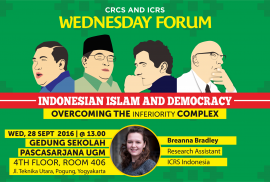Azis Anwar Fachrudin | CRCS UGM | Opinion

Despite the fact that Jakarta Governor Basuki “Ahok” Thahaja Purnama has apologized for statements made regarding the Quranic verse Al-Maidah 51, some Islamic groups are saying that an apology is not enough. Protestors demanded that Ahok be criminalized in a rally last week in Jakarta.
Deputy secretary-general of the Indonesian Ulema Council (MUI) said on a TV show that religious defamation must be punished by “death, crucifixion or at least hand amputation and expulsion”. Even though he did not urge the state to adopt such a policy, but rather called on the processing of the case in accordance to the law on religious defamation, his remarks give the impression that Islamic law is that harsh.
The Quranic verses quoted by the MUI deputy secretary-general are known as the hirabah verses. Hirabah, which literally means “warfare”, and the verses were basically applied under the principles of Islamic jurisprudence to crimes such as highway robbery, piracy, unlawful rebellion and sedition. The verses were the same verses used by the Islamic state (IS) group to justify its crucifying of those waging war against IS.
Therefore, the attribution for those punishments for alleged religious defamation is dangerous.
What is more saddening is that Islamic groups are pushing for Ahok to be criminalized when he had no intention of insulting Islam or the Quran. The groups are insisting that the literal out-of-context interpretation of al-Maidah:51 is the only correct one. They take for granted that the verse literally prohibits non-Muslims from being a “leader” in a Muslim country.
The word auliya is not translated as “leader” in most contemporary translations as well as tafsir, the consequence of that translation is dangerous: non-Muslim ministers, regents, even bosses in companies where Muslims work are also leaders, aren’t they? Must they be dismissed from their positions just because of the verse?
The verse will only make sense if understood in its context, that is, in a situation of war, such as when the Jews were said to have betrayed the Muslims by violating the social contract made between the two to defend Medina together when the city-state was under attack; hence the later prohibition to make the Jews “allies” (the closest meaning to the word“auliya”).
Read more http://www.thejakartapost.com/
________________________
The writer is a graduate student at the Center for Religious and Cross-cultural Studies (CRCS) at Gadjah Mada University, Yogyakarta.
NU

Abstract
Indonesian Islam connotes a pluralistic form of faith that is open and deeply engages local-specific cultures that concurrently emphasize a rigorous pursuit of social justice and equality for all. Despite the voluminous scholarship on Indonesian Islam, its correlation with Muhammadiyah’s “Islam Berkemajuan” and Nahdhatul Ulama’s “Islam Nusantara”—each having its own vision for a good society—remains woefully unexplained. This paper explores the interplay between Indonesian Islam and the praxis of democracy within the historical context of overcoming an apparent inferiority complex suffered by some segments of the Muslim community. The authors argue that as much as Indonesian Islam may have proven itself to be distinct from ‘the other Islams’, commonly found in its birthplace in the Middle East, there is still much to be desired for in terms of how to confidently overcome the historical baggage as a once colonized people. Using Said and Foucault’s analytical frameworks, the paper argues for a less humble attitude toward the propagation of Indonesian Islam to the outside world, given the protracted period of instability in the Middle East, ongoing terror attacks in different parts of the world and the politics surrounding Islamophobia.
Speaker
Breanna Bradley is an undergraduate student at Georgetown University’s Edmund A. Walsh School of Foreign Service located in Washington, District of Columbia, USA. Bradley’s studies focus on the relationship between culture and politics in Southeast Asia. She is currently a research assistant at the Indonesian Consortium for Religious Studies (ICRS), a Ph.D. program in Inter-Religious Studies located at Universitas Gadjah Mada, Yogyakarta, Indonesia. She has previously held positions as an undergraduate research fellow at Georgetown University’s Berkley Center for Religion, Peace and World Affairs and as a program coordinator for Georgetown University’s D.C. School’s Project, a program aimed to provide English language access for the immigrant community of the Washington DC area. She is interested in the role that Indonesian Islam plays in Indonesian culture and politics and is currently assisting with research surrounding the Tabot festival, a festival with its roots in Shia Islam celebrated by a majority Sunni community every year in Bengkulu, Sumatra.
Azis Anwar Fachrudin | CRCS | Article
As the Islamic State (IS) organization destroyed ancient statues aged thousands of years at the Mosul museum in Iraq last month, almost at the same time some Muslims demanded that the Jayandaru statues in the Sidoarjo town square in East Java should be torn down too. Their reasons were similar: They regarded the statues as idols being worshipped and idolatry is considered part of polytheism or shirk, the biggest and most unforgivable sin in Islam. Sadly, the demands in Sidoarjo were primarily supported by GP Ansor, the youth wing of the supposedly “moderate” Nahdlatul Ulama (NU).
 NU is often associated with being against “purification” (a literal interpretation of Islam) and it usually would be in the forefront of safeguarding “holy graves” against the threat of destruction, particularly the graves where those considered Muslim saints are buried. The NU highly condemns IS, including its blasting of holy shrines like the tomb of the Prophet Jonah (Yunus) in Iraq, and the actions of al-Nusra, such as its destruction of the grave of the leading imam an-Nawawi in Syria.
NU is often associated with being against “purification” (a literal interpretation of Islam) and it usually would be in the forefront of safeguarding “holy graves” against the threat of destruction, particularly the graves where those considered Muslim saints are buried. The NU highly condemns IS, including its blasting of holy shrines like the tomb of the Prophet Jonah (Yunus) in Iraq, and the actions of al-Nusra, such as its destruction of the grave of the leading imam an-Nawawi in Syria.
In fact, the embryo of NU in the early 20th century was a movement protesting the destruction of tombs of respected Muslim figures and sites that had historic importance for Muslims in Saudi Arabia (named Hijaz at that time). The destruction was carried out under the convictions of Wahhabism that regarded those shrines as sources of shirk.
What we are now dealing with is here, however, are statues, which is different from the contentious status of holy tombs. Many Muslims still visit graves of the holy figures; there is no clear prohibition of such a practice in primary Islamic sources of teachings. Yet there are several explicit prohibitions based on hadiths or prophetic traditions (which are secondary sources) of making full-figured statues or images of living creatures, either human or animal.
IS justifies its actions with those hadiths, relying also on the narrated story that the Prophet Muhammad commanded the destruction of statues (or, to be precise, idols) surrounding the Ka’ba in the eighth year following his conquest of Mecca.
The same justification was employed also by Afghanistan’s Taliban when in 2001 they blew up the two giant statues of Buddha in Bamiyan made in the 6th century — without knowing that there is no concept of a personal God in Buddhism, which is a non-theistic religion, and the statues of Shakyamuni Buddha are not subject to worship in the sense understood by monotheists.
That is it. Without denying the possibility of the political or economic factors in the aforementioned cases, the question here is whether Islam promotes iconoclasm or the destruction of idols. Iconoclasm is not unique to Islam (or, to be exact, Muslims); Judaism and Christianity also share history or scriptural teachings of iconoclasm. The story of the golden statue of a calf in the time of Moses is shared by the three religions. Iconoclasm was commanded by Hezekiah, the king of Judah (Two Kings 18:4) and King Josiah (Two Kings 23:1-20).
It appears also in the rabbinical Midrash, the story of Abraham as the iconoclast destroying idols made by his father. In Christianity, disputes over iconoclasm occurred in the Byzantine and Protestant Reformation era.
That is what is narrated in the scripture or “history”. As for Islam, while the Prophet Abraham is reported in the Koran to be destroying idols (asnam) of his people (Koran 21:52-67), the holy book says of King Solomon, considered a prophet by Muslims, that “they [the jinns] made for him [i.e. Solomon] what he willed: synagogues and statues [tamathil], basins like wells and boilers built into the ground.”
The Koranic terminology appears to differentiate between a mere statue (timthal) and an idol or statue being worshipped (sanam).
Muslim scholars all agree that it is prohibited for Muslims to worship statues because it makes them idolatrous. But that distinction between timthal and sanam matters very much when it comes to the contentious status of statues that are not worshipped.
Some Muslim scholars, such as the leading reformer Muhammad Abdul, Jadul-Haq (a former Grandsheikh of al-Azhar), and Muhammad Imarah (a renowned Muslim thinker), argued that it is allowed to have statues as long as they are not worshipped.
And in the fundamentals of Islamic jurisprudence (usul al-fiqh), “rulings are based on their raison d’etre [‘illah al-hukm]; when the raison d’etre disappears, the rulings do not prevail.”
That argument is supported by historical evidence of the early Muslim generations. The companions of the Prophet (such as Amr ibn al-Ash in Egypt and Sa’d ibn Abi Waqqas in Iraq) led conquests in many places, but did not destroy the ancient statues they found, because those statues were no longer worshipped.
Sphinxes still exist in Egypt. Those Mesopotamian statues had been there for centuries before being demolished by IS. The Bamiyan Buddha statues were there before being attacked by the Taliban.
In fact, when the Taliban were under Mullah Mohammed Omar, he once issued a decree in favor of the preservation of the Bamiyan statues by arguing that, besides the fact that a Buddhist population no longer existed in Afghanistan, the statues could be a potential major source of tourism income for Afghanistan.
Statues in the Borobudur Buddhist temple are also still there, although nine stupas were damaged during the 1985 Borobudur bombing. In general, most Muslims, either as a minority like in India or as a majority like in Indonesia, have no problem with statues, unlike those who prefer a literal interpretation of the Prophet’s sayings, or hadiths. Scripturalism is the very problem of IS-like Muslims; it denies the imperative that scripture must be contextualized with surrounding circumstances and contrasted with historical evidence.
Furthermore, in the heart of the holiest site for Muslims — the Ka’ba — there is a black stone (al-hajar al-aswad), that was venerated in the pre-Islamic pagan era and is kissed by Muslims while doing pilgrimage. That stone is considered sacred by many Muslims; some of them touch it to get sort of blessing or expiation of sins. And in regard to this practice, the second caliph Umar ibn al-Khattab has frequently been quoted as saying, “I know that you are a stone and can neither harm nor benefit anyone. Had I not seen the Messenger kissing you, I would not have kissed you.” That is, it is not statues, images, or stones that matter; it is Muslim minds that do.
For some nahdliyin (NU members), then, can we regard those statues in Sidoarjo as merely statues or stones that are not worshipped?




